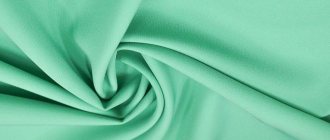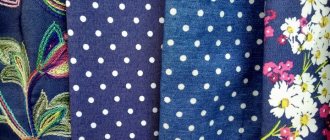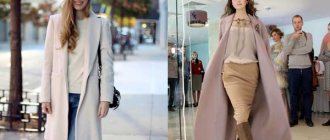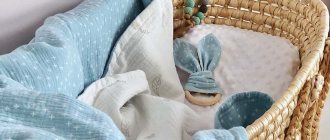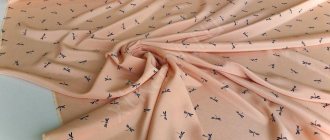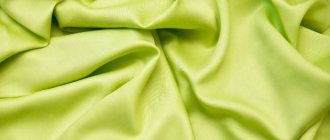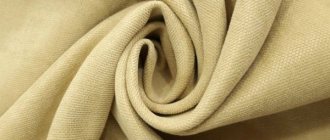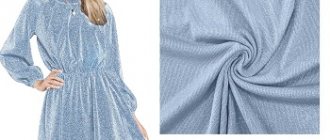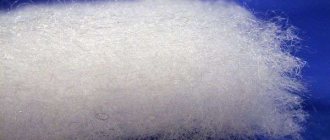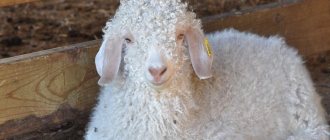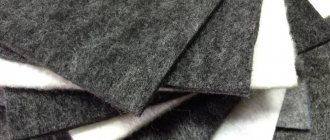What type of fabric is this?
Lyocell is the result of applying high technology to eucalyptus fiber (an evergreen woody plant of the myrtle family). Its wood is exposed to a mild organic solvent until it becomes a soft and delicate fiber. The material obtained in this way is considered absolutely safe, and its production does not pollute the environment.
Lyocell colors
Main stages of lyocell production:
- dissolving cellulose to obtain pulp - a paste-like mixture;
- filtering the mixture and cooling it;
- fiber formation.
The resulting fiber is woven on a loom using different weaving methods to produce a lightweight fabric with a soft and silky surface.
Lyocell is registered under several trademarks - “Orcel” (Russia) and “Tensel” (USA). These two states produce this nanomaterial. In addition, the production of lyocel is being established in China and South Korea.
Manufacturing process
One of the amazing features of the new fabric is its environmentally friendly production. Almost for the first time, environmentalists recognized that the technology for creating artificial fiber is absolutely safe, for which it was even awarded a special European Environmental Protection Award.
Production stages: from plant to clothing
Against the background of viscose production, the process of creating lyocell is simplified to a minimum:
| Base – cellulose (pine) | Base – cellulose (eucalyptus) |
| viscose fibers: production stages | Lyocell fibers: production stages |
| mercerization | |
| pre-ripening | |
| xanthogenation | |
| dissolution | dissolution |
| filtration | filtration |
| maturation | |
| deaeration | |
| molding | molding |
| fiber cutting | |
| post-processing | post-processing |
The table clearly shows the lengthy and not at all environmentally friendly process of making viscose. Another thing is the production of lyocell fibers, in which NMMO, an organic solvent, is used to dissolve cellulose. During this process, no harmful substances are formed, which cannot be said about the production of viscose, where carbon disulfide is used to dissolve cellulose.
The main stages of creating lyocell:
- Dissolution. Already during this stage, the new fibers acquire the properties of cotton, which is created during the transformation of cellulose with an organic solvent. This process is divided into several stages:
- processing raw materials with water to obtain pulp;
- evaporation of water and addition of MMO (methylmorpholine oxide) to the pulp;
- mixing components and heating up to +100 degrees;
- cooling the solution in the precipitation bath.
- Formation. At this stage, the fibers are pulled towards the axis, as a result of which the bonds between the molecules are broken, followed by new crystallization.
As a result of this technology, the fibers acquire completely unique properties, thanks to which the new fabric conquered the market in just a few years.
Fabric composition and its properties
In appearance, lyocell resembles silk, in tactile sensations it is similar to cotton, and in strength it is similar to satin.
Cotton
What are the properties of cotton or cotton fabric? What are its areas of application?
more details
Satin
What is satin fabric? How is it made and what are its properties?
more details
Silk
Fame and luxury: a detailed review of silk fabric
more details
Main properties of the material:
Durability - does not tear when wet and has high wear resistance
Hygroscopic, absorbs moisture well
Smoothness and silkiness
Hypoallergenic - does not cause skin irritation
Does not accumulate dust
Breathability
Easy to use and maintain
Hygienic properties
Knowing what hygienic properties eucalyptus material has, you can solve most problems. It retains all the healing properties of wood, which makes it indispensable for making home textiles. Bed linen has the following properties:
- The fabric feels soft and silk-like. Possesses the properties of cotton fabric.
- It has the ability to not wrinkle or fade when washed.
- Does not slip on the surface, antistatic.
- It has high wear resistance,
- Absorbs sweat perfectly.
- The antiseptic properties of the fabric make it hygienically safe.
Note! Knowing what lyocell fabric is, it can be safely used for sewing bedding for children.
Types of fabric
Due to its high cost, it is extremely rare in its pure form, so it is most often combined with elastane and modal, and sometimes with cotton, wool, and viscose. High-quality material contains at least 50% lyocell.
Modal
What is modal fabric made from and what are its characteristics and approximate cost?
more details
Elastane
Artificial elastane fabric: from production and properties to areas of use
more details
Lyocell base
Eucalyptus is the basis for lyocell.
Obtaining an artificial fiber that is as close as possible to natural fiber in its qualities is a long-standing dream of scientists. It was implemented by British specialists in 1988. During their experiments, they created a type of viscose based on eucalyptus wood. The fabric was first introduced in 1991, and since 1997 it began to be produced on an industrial scale.
Today it is produced in the USA under the name Tencel, and in Russia, where it was developed by the Scientific Institute of Polymer Fibers in Mytishchi, it is known as Orcel.
The new fibers are based on cellulose extracted from eucalyptus wood. Although the fibers are of artificial origin, the unique properties of this tree were transferred to them.
In terms of tactile and external characteristics, the new fabric is not inferior to silk, cotton and wool. It is rarely found in its pure form, as it is very expensive, but in combination with other fibers, the following may be indicated on clothing and linen labels:
- lyocell and elastane;
- lyocell + elastane + modal.
The percentage of lyocell in the mixed material can vary, but it is better if it is 50% or higher. Nowadays, clothes, bedding and underwear are made from such fabric, and it is used in medicine.
For what purposes can it be used?
Lyocell is widely used in the textile industry; it is used to sew:
Clothes for adults and children
Underwear
Bed sheets
The antiseptic properties inherent in eucalyptus are preserved in the finished material, which allows it to be used in medicine for the production of bandages and dressings. In addition, the material is used to make car covers and filler for air filters.
Material care
It's easy to care for the material. Products made from it should be stored in a dry, regularly ventilated place. Can be washed by hand or machine; ironing is rarely required.
Washing and drying
You can wash the fabric by hand or in a machine on a delicate cycle. For washing, use powder or gel detergent. Spin at low speeds is allowed.
Tumble dry at home or outside, but avoid direct sun. It is not advisable to dry it on radiators or near an open fire. Pillows and blankets with lyocell filling should be periodically ventilated and dried in the sun.
How to iron fabric
You need to iron completely dry or slightly damp items. Set the iron to “silk” mode or a temperature of less than 110 degrees. For ironing, items are turned inside out. The fabric wrinkles slightly, but if necessary, you can use a steamer to smooth the item.
How to properly care
Careful care of the fabric and filling will ensure many years of use. Pillows, blankets and bedding will remain beautiful and functional.
- Wash products and lyocell in warm water by hand or machine on a delicate cycle.
- Spin at minimum speed.
- When hand washing, lightly wring and place to drain.
- Dry items hung vertically or laid out on a surface out of direct sunlight.
- Iron clothes from the wrong side with minimal iron heat.
- To store things made from lyocell, you need a dry place and ventilated covers. Keep in mind that fiber has the property of absorbing moisture and as a result mold appears.
When storing pillows and blankets for a long time, ventilate them.
Scope of application: what is sewn from fabric
It is noteworthy that lyocell has a second name: tencel or tencel. But the second name is not popular. Under any circumstances, the material is used only in the following industries.
Cloth
The fabric is widely used in light industry. At first it was used to sew luxury clothes for adults, and then they began to sew it for children, because the material is safe. This is an excellent material for sewing summer assortments as it is cool on the skin and fits perfectly to the figure. The fabric does not wrinkle or fade, and caring for it is quite simple. It is stronger than jeans, so it is used to make trousers. The product does not form pills and makes ideal evening dresses and suits.
You might be interested in Features of using Alcantara for sewing car covers
Lyocell dress
Bed dress
Lyocell has properties similar to cotton fabric, which is why bed linen is made from it. It serves for a long time, but does not change its appearance, quality, and can withstand numerous washes. The fabric is soft and silky, slightly cools the skin and does not cause allergies. The price of such underwear is high, not everyone can afford it, but when mixed with silk or cotton, it is quite accessible to a wide segment of the population.
Lyocell filler in pillows and blankets
Lyocell fibers have a bactericidal and hypoallergenic effect, so they are used as filler for pillows and blankets. These accessories retain their shape and elasticity for a long time, do not roll down and are well ventilated. Harmful microorganisms do not develop in lyocell blankets, as well as in pillows, which is good for allergy sufferers. The eucalyptus fiber filling is warm to the touch and has non-harmful properties. To reduce product prices, eucalyptus fibers are diluted with holofiber.
Lyocell bed linen
High hygienic properties give the right to manufacture bandages. In industry, lyocell is used for machine covers, conveyor belts and air purifying filters.
Why is it environmentally friendly?
In addition to the fact that lyocell is safe and comfortable to use, it is also quite environmentally friendly. Eucalyptus grows quickly, with virtually no pesticides. No toxic chemicals are used to produce lyocell, and 99.5% of the wood solvent can be reused. The production of this material uses half as much water as when creating cotton. Due to the fact that the fabric is highly breathable, the item will not acquire an unpleasant odor after the first wear, which means it does not need to be washed too often. However, it cannot be said that the production of lyocell does not harm the planet at all. According to the scientific director of the Swedish program Mistra Future Fashion, Suzanne Sweet, the main factors influencing production on the environment are the waste of natural resources and the impact on the climate. Therefore, if a fabric is produced in countries that use fossil fuels, it cannot be considered sustainable.
Sweet emphasizes that it is important to understand not only whether the material itself is pure, but also to be able to trace its production from the original source to the final product. Unfortunately, this information is often difficult to access for the average consumer.
History of appearance
About 30 years ago, the English company Courtaulds Fibers became one of the first to produce viscose fiber from cellulose. Despite the costly production method, high energy consumption, and the use of harmful chemical components, the new viscose material quickly gained popularity. However, attempts to come up with a safer and cheaper alternative did not stop.
In 1988, specialists from the same company replaced the environmentally harmful carbon disulfide used to dissolve cellulose with an organic solvent. This made the process of obtaining fiber, which in essence and chemical composition remained the same viscose, environmentally friendly. And its production has accelerated and become cheaper.
The material obtained using the new technology was called lyocell. In Russia, the innovative fabric is registered under the Orcel trademark and is produced in the Ivanovo region. In America, the material is produced under the name tencel (tensel, tencel).
Advantages
The main advantage of lyocell is strength and wear resistance. It does not lose color for a long time, smooths out easily, and stretches well. Lyocell is breathable and absorbs moisture. In addition, it has bactericidal properties. The structure of the fibers prevents the fabric from accumulating dust, so it is suitable for allergy sufferers or people with sensitive skin.
In essence, lyocell combines the advantages of natural and artificial fibers: strength, ease of manufacture, and environmental friendliness. All this makes eucalyptus fiber one of the most promising textile materials.
Read on topic:Sustainable fashion: how science helps make clothing production environmentally friendly
Reviews about unique cellulose
Not much time has passed since the industrial production of lyocell fabric, but it has regular consumers. In their reviews they indicate only positive comments. The negative side is the high price of the products, which is not affordable for everyone.
- Olga, 37 years old, Krasnodar: “I bought myself an evening dress made of mixed fabric, which contains 80% eucalyptus. I don't regret spending a lot of money. I feel like wearing natural cotton. It’s especially pleasant in our hot climate, you hardly sweat in it and it’s very pleasant to the touch.”
- Victor, 42 years old, Norilsk: “A friend told me that there is a fabric that looks like new over time. I don’t know what kind of material this is or if this happens. My dream is to buy a shirt so that it never wears out. A friend has a turtleneck like this, he’s been wearing it for years, and it’s like new.”
- Valentina, 28 years old, Voronezh: “My friends recently gave me a set of lyocell bed linen. I would never buy such expensive underwear myself. Although the fabric is considered artificial, it looks like natural silk when touched. The palette is gorgeous, I’ve washed it more than once and haven’t faded at all, no pilling, easy to iron. I sleep like a queen, enjoying the pleasant wrapping of fabric around my overworked body.”
Lyocell is a new generation material. Its production is safe and does not harm nature. The only problem is that 100% lyocell is incredibly expensive, which makes it inaccessible to people with average incomes. But the mixed options are no worse and the price is quite acceptable.
Advantages and disadvantages of matter
In the fabric market, the demand for lyocell is constantly growing. Matter has a lot of advantages in use and practically no disadvantages. The advantages include:
- The fabric is pleasant and comfortable to wear.
- Retains its excellent appearance and shiny surface for a long time.
- Does not fade when washed, is available in a wide range of colors.
- It stretches a little, perfectly fitting the figure.
- Keeps its shape for a long time of use.
- No pellets form on the surface. Can be steamed with an iron.
- Does not accumulate pathogenic microflora and does not contribute to allergy attacks.
Lyocell cannot be cheap.
But the material also has disadvantages:
- High price.
- Shrinks a little when washed.
- Increased hygroscopicity is not always welcome.
Note! Knowing everything about lyocell fabric, what it is and how to care for it, feel free to purchase products made from it and enjoy its excellent properties.
Application
In the early years, the production of lyocell was focused on the production of women's clothing only. Today, men's and children's clothes are also sewn from this fabric, which in a short period of time have gained the trust of millions of consumers.
Following this, lyocell found its use in the production of home textiles - pillows, blankets, mattress covers, bed linen - in a fairly wide range. Having a luxurious appearance, it is able to satisfy the requirements of any consumer.
Due to their strength and wear resistance, fibers are used to produce cables, air filters, conveyor belts, protective covers, and in medicine - dressing materials.
